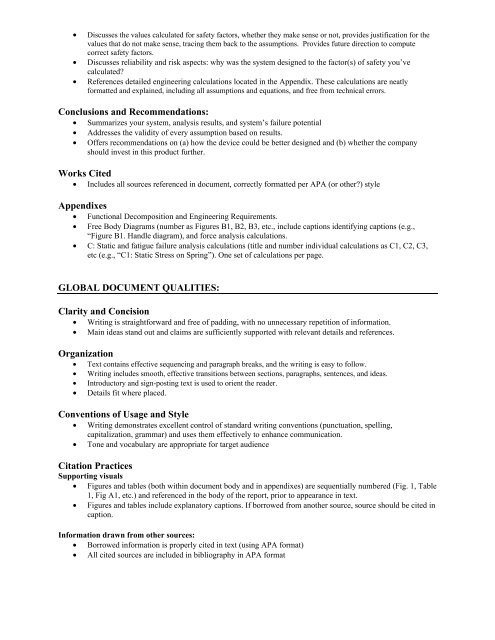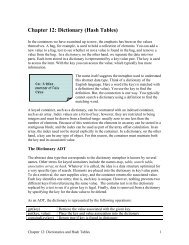Project Report Guidelines - Classes
Project Report Guidelines - Classes
Project Report Guidelines - Classes
You also want an ePaper? Increase the reach of your titles
YUMPU automatically turns print PDFs into web optimized ePapers that Google loves.
• Discusses the values calculated for safety factors, whether they make sense or not, provides justification for the<br />
values that do not make sense, tracing them back to the assumptions. Provides future direction to compute<br />
correct safety factors.<br />
• Discusses reliability and risk aspects: why was the system designed to the factor(s) of safety you’ve<br />
calculated?<br />
• References detailed engineering calculations located in the Appendix. These calculations are neatly<br />
formatted and explained, including all assumptions and equations, and free from technical errors.<br />
Conclusions and Recommendations:<br />
• Summarizes your system, analysis results, and system’s failure potential<br />
• Addresses the validity of every assumption based on results.<br />
• Offers recommendations on (a) how the device could be better designed and (b) whether the company<br />
should invest in this product further.<br />
Works Cited<br />
• Includes all sources referenced in document, correctly formatted per APA (or other?) style<br />
Appendixes<br />
• Functional Decomposition and Engineering Requirements.<br />
• Free Body Diagrams (number as Figures B1, B2, B3, etc., include captions identifying captions (e.g.,<br />
“Figure B1. Handle diagram), and force analysis calculations.<br />
• C: Static and fatigue failure analysis calculations (title and number individual calculations as C1, C2, C3,<br />
etc (e.g., “C1: Static Stress on Spring”). One set of calculations per page.<br />
GLOBAL DOCUMENT QUALITIES:<br />
Clarity and Concision<br />
• Writing is straightforward and free of padding, with no unnecessary repetition of information.<br />
• Main ideas stand out and claims are sufficiently supported with relevant details and references.<br />
Organization<br />
• Text contains effective sequencing and paragraph breaks, and the writing is easy to follow.<br />
• Writing includes smooth, effective transitions between sections, paragraphs, sentences, and ideas.<br />
• Introductory and sign-posting text is used to orient the reader.<br />
• Details fit where placed.<br />
Conventions of Usage and Style<br />
• Writing demonstrates excellent control of standard writing conventions (punctuation, spelling,<br />
capitalization, grammar) and uses them effectively to enhance communication.<br />
• Tone and vocabulary are appropriate for target audience<br />
Citation Practices<br />
Supporting visuals<br />
• Figures and tables (both within document body and in appendixes) are sequentially numbered (Fig. 1, Table<br />
1, Fig A1, etc.) and referenced in the body of the report, prior to appearance in text.<br />
• Figures and tables include explanatory captions. If borrowed from another source, source should be cited in<br />
caption.<br />
Information drawn from other sources:<br />
• Borrowed information is properly cited in text (using APA format)<br />
• All cited sources are included in bibliography in APA format

















